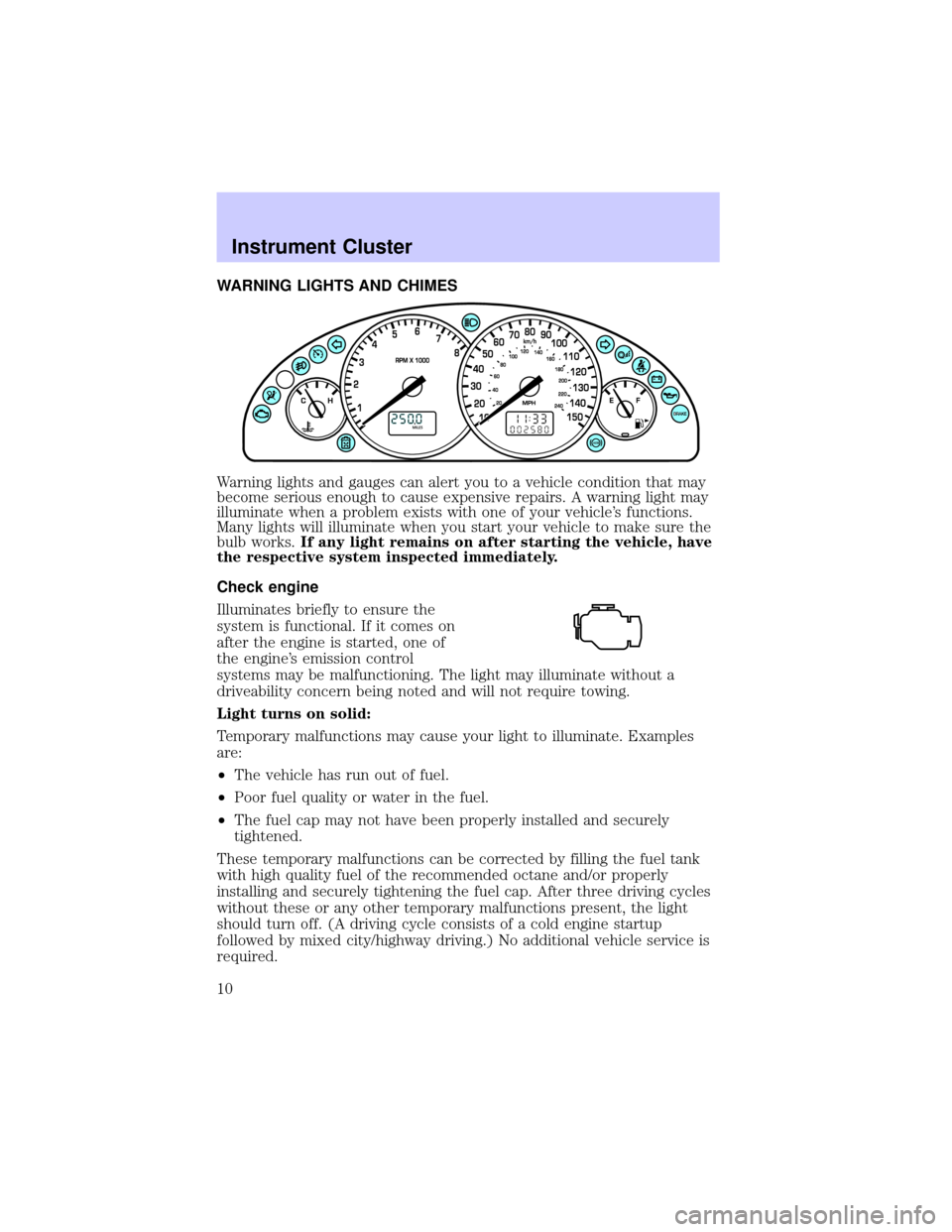octane Mercury Mercury Cougar 2002 Owner's Manual
[x] Cancel search | Manufacturer: MERCURY, Model Year: 2002, Model line: Mercury Cougar, Model: Mercury Mercury Cougar 2002Pages: 216, PDF Size: 4.04 MB
Page 10 of 216

WARNING LIGHTS AND CHIMES
Warning lights and gauges can alert you to a vehicle condition that may
become serious enough to cause expensive repairs. A warning light may
illuminate when a problem exists with one of your vehicle's functions.
Many lights will illuminate when you start your vehicle to make sure the
bulb works.If any light remains on after starting the vehicle, have
the respective system inspected immediately.
Check engine
Illuminates briefly to ensure the
system is functional. If it comes on
after the engine is started, one of
the engine's emission control
systems may be malfunctioning. The light may illuminate without a
driveability concern being noted and will not require towing.
Light turns on solid:
Temporary malfunctions may cause your light to illuminate. Examples
are:
²The vehicle has run out of fuel.
²Poor fuel quality or water in the fuel.
²The fuel cap may not have been properly installed and securely
tightened.
These temporary malfunctions can be corrected by filling the fuel tank
with high quality fuel of the recommended octane and/or properly
installing and securely tightening the fuel cap. After three driving cycles
without these or any other temporary malfunctions present, the light
should turn off. (A driving cycle consists of a cold engine startup
followed by mixed city/highway driving.) No additional vehicle service is
required.
Instrument Cluster
10
Page 185 of 216

Octane recommendations
Your vehicle is designed to use
ªRegularº unleaded gasoline with
pump (R+M)/2 octane rating of 87.
We do not recommend the use of
gasolines labeled as ªRegularº that
are sold with octane ratings of 86 or lower in high altitude areas.
For Cougar S vehicles, please use ªPremiumº unleaded gasoline with
an octane rating of 91.
Do not be concerned if your engine sometimes knocks lightly. However, if
it knocks heavily under most driving conditions while you are using fuel
with the recommended octane rating, see your dealer or a qualified
service technician to prevent any engine damage.
Fuel quality
If you are experiencing starting, rough idle or hesitation driveability
problems during a cold start, try a different brand of ªRegularº unleaded
gasoline. ªPremiumº unleaded gasoline is not recommended (particularly
in the United States) because it may cause these problems to become
more pronounced. If the problems persist, see your dealer or a qualified
service technician.
It should not be necessary to add any aftermarket products to your fuel
tank if you continue to use high quality fuel of the recommended octane
rating. Aftermarket products could cause damage to the fuel system.
Repairs to correct the effects of using an aftermarket product in your
fuel may not be covered by your warranty.
Many of the world's automakers
issued the World-wide Fuel Charter
that recommends gasoline
specifications to provide improved
performance and emission control
system protection for your vehicle.
Gasolines that meet the World-wide
Fuel Charter should be used when
available. Ask your fuel supplier
about gasolines that meet the
World-wide Fuel Charter. In Canada,
look for fuels that display theAuto Makers' Choiceylogo.
Cleaner air
Ford endorses the use of reformulated ªcleaner-burningº gasolines to
improve air quality.
87(R+M)/2 METHOD
Maintenance and Specifications
185
Page 186 of 216

ESSENTIALS OF GOOD FUEL ECONOMY
Measuring techniques
Your best source of information about actual fuel economy is you, the
driver. You must gather information as accurately and consistently as
possible. Fuel expense, frequency of fill-ups or fuel gauge readings are
NOT accurate as a measure of fuel economy. We do not recommend
taking fuel economy measurements during the first 1 600 km (1 000
miles) of driving (engine break-in period). You will get a more accurate
measurement after 3 000 km±5 000 km (2 000 miles-3 000 miles).
Filling the tank
The advertised fuel capacity of the fuel tank on your vehicle is equal to
the rated refill capacity of the fuel tank as listed in theRefill capacities
section of this chapter.
The advertised capacity is the amount of the indicated capacity and the
empty reserve combined. Indicated capacity is the difference in the
amount of fuel in a full tank and a tank when the fuel gauge indicates
empty. Empty reserve is the small amount of fuel remaining in the fuel
tank after the fuel gauge indicates empty.
The amount of usable fuel in the empty reserve varies and should
not be relied upon to increase driving range. When refueling your
vehicle after the fuel gauge indicates empty, you might not be
able to refuel the full amount of the advertised capacity of the
fuel tank due to the empty reserve still present in the tank.
For consistent results when filling the fuel tank:
²Turn the engine/ignition switch to the off position prior to refueling,
an error in the reading will result if the engine is left running.
²Use the same filling rate setting (low Ð medium Ð high) each time
the tank is filled.
²Allow no more than 2 automatic click-offs when filling.
²Always use fuel with the recommended octane rating.
²Use a known quality gasoline, preferably a national brand.
²Use the same side of the same pump and have the vehicle facing the
same direction each time you fill up.
²Have the vehicle loading and distribution the same every time.
Your results will be most accurate if your filling method is consistent.
Calculating fuel economy
1. Fill the fuel tank completely and record the initial odometer reading
(in kilometers or miles).
Maintenance and Specifications
186
Page 201 of 216

ENGINE DATA
Engine 2.0L engine 2.5L engine
Cubic inches 121 152
Required fuel 87 octane 87 octane
Firing order 1±3±4±2 1±4±2±5±3±6
Spark plug gap 1.37 mm (0.054 inch) 1.37 mm (0.054 inch)
Ignition systemElectronically
ControlledElectronically
Controlled
VEHICLE DIMENSIONS
Vehicle dimensions mm (in)
(1) Overall length 4720 (186)
(2) Overall width 1769 (69.6)
(3) Overall height 1325 (52.2)
(4) Wheelbase 2 704 (106.5)
(5) Track - Front 1506 (59.3)
(5) Track - Rear 1491 (58.7)
Maintenance and Specifications
201
Page 209 of 216

dipstick ....................................172
filter, specifications ........174, 198
recommendations ...................174
refill capacities ........................199
specifications ..................200±201
Exhaust fumes ..........................116
F
Floor mats ...................................68
Fluid capacities .........................199
Foglamps .....................................47
Fuel ............................................182
calculating fuel economy .......186
cap ...........................................183
capacity ...................................199
choosing the right fuel ...........184
comparisons with EPA fuel
economy estimates .................188
detergent in fuel .....................185
filling your vehicle with
fuel ...........................182±183, 186
filter, specifications ................198
fuel pump shut-off switch .....135
gauge .........................................17
improving fuel economy ........186
low fuel warning light ..............13
octane rating ...................185, 201
quality ......................................185
safety information relating to
automotive fuels .....................182
Fuses ..................................136±137
G
Gas cap (see Fuel cap) ............183
Gas mileage (see Fuel
economy) ...................................186
Gauges .........................................16engine coolant temperature
gauge .........................................16
fuel gauge ..................................17
odometer ...................................17
speedometer .............................17
tachometer ................................18
trip odometer ............................18
GAWR (Gross Axle Weight
Rating) .......................................129
definition .................................129
driving with a heavy load ......129
location ....................................129
GVWR (Gross Vehicle Weight
Rating) .......................................129
calculating ...............................129
definition .................................129
driving with a heavy load ......129
location ....................................129
H
Hazard flashers .........................135
Headlamps ...................................47
aiming ........................................49
bulb specifications ....................51
daytime running lights .............47
flash to pass ..............................48
high beam ...........................14, 48
turning on and off ....................47
warning chime ..........................15
Heating
heating and air conditioning
system .......................................44
Hood ..........................................168
I
Ignition ...............................112, 201
Infant seats
(see Safety seats) .....................106
Index
209
Page 210 of 216

Inspection/maintenance (I/M)
testing ........................................190
Instrument panel
cleaning ...................................164
cluster ........................................10
lighting up panel and
interior .......................................48
J
Jack ............................................142
positioning ...............................142
storage .....................................142
Jump-starting your vehicle ......145
K
Keys .......................................74±76
key in ignition chime ...............16
positions of the ignition .........112
L
Lamps
bulb replacement
specifications chart ..................51
cargo lamps ...............................48
daytime running light ...............47
fog lamps ...................................47
headlamps .................................47
headlamps, flash to pass ..........48
instrument panel, dimming .....48
interior lamps ...........................50
replacing bulbs .........................51
Lane change indicator
(see Turn signal) ........................50
Lights, warning and indicator ....10
air bag ........................................12
anti-lock brakes (ABS) ....11, 117
brake ..........................................11
charging system ........................12check coolant ............................12
check engine .............................10
cruise indicator .........................13
door ajar ....................................15
high beam .................................14
low fuel ......................................13
low washer fluid .......................15
oil pressure ...............................12
overdrive off ..............................13
safety belt .................................12
speed control ............................65
traction control active ..............13
turn signal indicator .................13
Load limits .................................129
GAWR ......................................129
GVWR ......................................129
trailer towing ..........................129
Locks
doors ..........................................70
Lubricant specifications ...200±201
M
Manual transaxle
fluid capacities ........................199
lubricant specifications ..........201
reverse .....................................127
Manual transmission .................125
Message center ...........................66
Mirrors
side view mirrors (power) .......60
Moon roof ....................................65
Motorcraft parts ........................198
O
Octane rating ............................185
Odometer .....................................17
Oil (see Engine oil) ..................172
Index
210